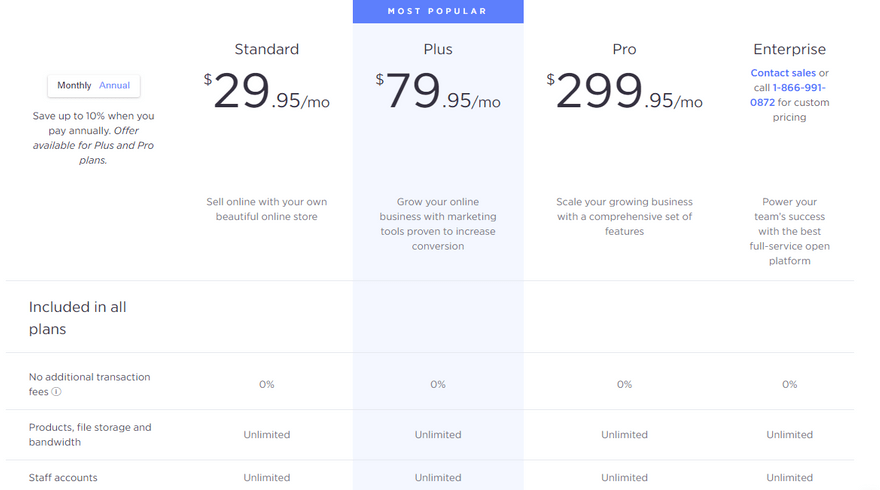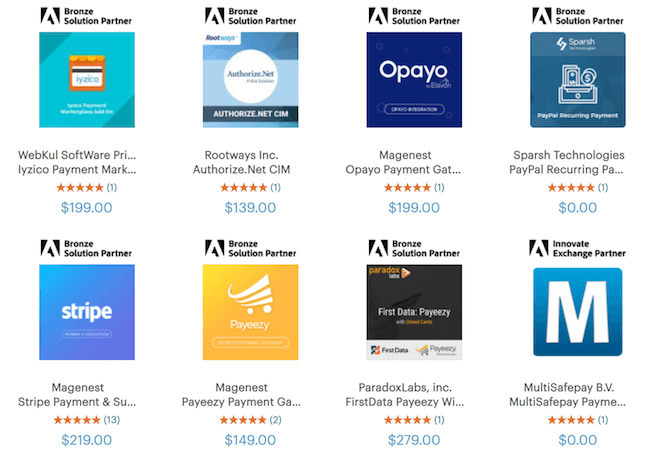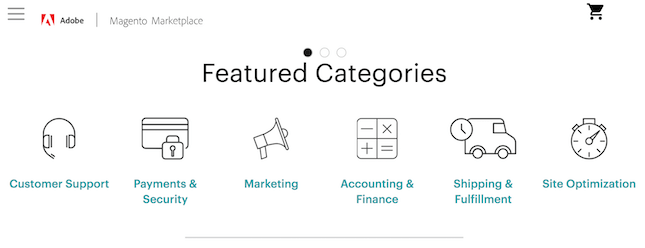BigCommerce Vs Magento: A Close Ecommerce Contest?
Our independent research projects and impartial reviews are funded in part by affiliate commissions, at no extra cost to our readers. Learn more
BigCommerce vs Magento – it’s a matchup between two gladiators of the ecommerce world. Both will help you set up – and start selling through – an online store… but how do you know which one’s right for you?
Deciding which is the mightier platform is tricky, but we’ve done our research; testing, reviewing, and examining these two platforms on all the metrics that matter. In addition to this thorough research on each builder, we also asked people just like you to test them too.
Whether your top priority is ease of use, design flexibility, help and support, or a low price point, read on to find out which platform is the right fit for you.
Before we kick things off, though, here’s how the two builders stack up in terms of performance:
Now, let’s get started!
What's the Difference Between BigCommerce and Magento?
BigCommerce has helped almost 100,000 people start selling online, offering the most built-in features of any ecommerce platform.
Boasting some big name companies on its client roster – including Toyota, Kodak, and Ben & Jerry’s – BigCommerce has pretty much everything you need to sell across multiple channels, including social media. Plus, with a huge range of features included as standard – and with scalable pricing plans suitable for online stores of most sizes and experience levels – it’s ideal for businesses looking to grow fast.
Magento currently powers 250,000 online stores, handling over $100 billion in gross merchandise volume – so it’s clearly a popular choice! After its release in 2008, Magento was later acquired by eBay, before being sold to Adobe, who currently owns it.
Magento is an open-source ecommerce platform, which – for less tech-savvy users, at least – is both good and bad. On the plus side, anyone can use Magento for free. The caveat? You’ll only be able to take advantage of this if you have ample coding knowledge – so, as you can imagine, it’s not for everyone!
So, what’s the key difference between the two?
Well, BigCommerce is a ‘hosted’ ecommerce platform, and it comes as an all-in-one package.
BigCommerce is Saas (Software-as-a-Service), which means you won’t own the technology you’re using – rather, you’ll simply pay a single monthly fee to ‘lease’ the platform. You’ll start by building your site with a BigCommerce ‘theme’ – a kind of pre-built, tried-and-tested template, which is also completely customizable to you preferences.
While BigCommerce isn’t the cheapest platform of its kind, it’s designed to help you scale the size and scope of your brand and online presence. There are no tech skills necessary!
Magento, on the other hand. is open-source ecommerce software, and even offers its open-source edition totally free. That said, there are costs you’ll need to arrange separately – such as hosting, security measures and SEO apps – that you won’t have to pay when you opt for a ‘hosted’ ecommerce platform.
Magento is also a powerful platform, and offers ultimate creative control and flexibility – the snag is you’ll need to know how to code to personalize your site beyond its theme, and the average person will struggle to use it to its full potential.
This makes Magento best for large, enterprise-level businesses with development teams, or a large budget to hire someone to design their site.
You Should Use BigCommerce If….
- You value easy setup, with all the tools you need already at your disposal
- You’re not massively tech-savvy
- You want to sell across multiple channels, including social media
You Should Use Magento If…
- You have some experience in coding or building websites
- You’re happy to take on a larger project when it comes to your website
- You have a larger inventory, and are planning to sell thousands of products
Now you’re here…
Why not read our BigCommerce review, first – or see how Magento compares to Shopify?
BigCommerce vs Magento: Pros and Cons
BigCommerce Pros and Cons
| Pros: |
|
| Cons: |
|
Magento Pros and Cons
| Pros: |
|
| Cons: |
|
Ease of Use
The Winner
BigCommerce is easier to use than Magento
There are so many things to consider when running a business. You want to spend time focusing on your customers, products, and brand – not on building, customizing and editing a website. So just how easy is it to use BigCommerce and Magento?
Let’s start with BigCommerce. In our recent ‘ease of use’ testing, BigCommerce performed just about okay, scoring 3.3 stars out of a possible 5. Some of the things our tested users loved was how easy it was to locate and access the ecommerce platform’s features.
Here’s what one of our tested users had to say about BigCommerce:
“They really do think about all the extra features to make your user’s shopping experience that much more personal and enjoyable. With BigCommerce, they really support this and make sure you as the merchant are aware of these little extra add-ons by making it easy to tick a box and incorporate a feature, and they then do the rest.”
That said, other users we tested struggled with BigCommerce’s interface, suggesting that it’s UI (user interface) lacks intuitiveness, and struggling with aspects of the store creation they expected to be easier.
“It was frustrating, some of the things you thought would be easy weren’t. Or it would look apparent but it wasn’t apparent. I wanted to amend the homepage title and images, so I changed it, but it just didn’t look right and then the preview didn’t look the same.”
BigCommerce’s editing interface is split between two areas: the storefront (what your customers see) and inventory (the backend). It also uses complex terminology like SKU levels and CSV files, so it’s definitely aimed at more techy users. You’ll definitely need some time and patience to learn your way around BigCommerce’s finer points, but the fact that you don’t need any tech skills to use it is still a huge plus.
Plus, BigCommerce is continually introducing improvements and bug fixes, to make the platform more accessible to a wider (and less tech-oriented) audience. For instance, keyboard shortcuts – such as typing ‘AP’ to start adding products – let you quickly access core functionalities, while BigCommerce’s ‘Store Design’ feature lets you track the effects of your edits as you go.
Unfortunately, Magento shares some of BigCommerce’s worst aspects when it comes to ease of use – namely, in that it uses complicated terminology on each page. However, Magento is more difficult to use than BigCommerce overall, because you also need to know code. With BigCommerce, everything can be done with a few clicks, without any coding – so it’s much better for beginners.
Magento scored poorly in our ease of use testing, coming out with a disappointing 2.5 stars out of 5. If you’re a confident coder and have plenty of time to set up your store, you shouldn’t struggle too much, but we certainly don’t recommend Magento for absolute beginners.
Setup and Onboarding
The gulf between how easy BigCommerce and Magento are to use, respectively, is mirrored in how simple they are to get set up.
Magento, for instance, comes with an advanced setup process that’s pretty complicated. Even setting aside the technical jargon involved, Magento can be a challenge to install. Not only will you need to create a store, but you’ll need to connect it to a host as well. Moreover, many hosting providers don’t provide automatic installation, which makes the whole thing even more of a time suck.
Installing Magento is easier with a host that has Magento-specific hosting. We recommend checking out SiteGround’s Magento hosting plans, which includes free installation to make setting up your Magento site quicker and easier.
All this means that you’re much more likely to run into trouble on Magento, simply because there’s so much more you need to do. And, if you do find yourself in hot water, there’s no 24/7 phone support to get you out of it (but we’ll cover this in more detail later!).
The bottom line? If you choose Magento, be prepared for a longer, more arduous setup process!
BigCommerce, by contrast, is very easy to get set up. Because all the infrastructure is there for you already – and here we’re talking mainly about the customizable templates and hosting provision – you’re not starting entirely from scratch. That makes it much easier to create and launch your online store with BigCommerce, as opposed to Magento. In fact, BigCommerce is so committed to making it easy for you to launch your online store, you can even migrate your store to BigCommerce – from Magento!
Transfer Your Magento Store to BigCommerce With Ease
BigCommerce also allows you to migrate your store from Magento – it even has an app to make this process as easy as possible!
The app is called Catalog Transfer: Magento. It’s totally free, and removes the hassle of moving your products, categories, options, and customers from Magento to BigCommerce, by automating the entire process for you. This means you can get to selling faster, rather than wasting time ironing out technical difficulties or re-uploading products one by one.
BigCommerce’s in-house Catalog Transfer Team will walk you through the process and get you set up on your new platform, minus the headaches and frustrations of doing it all manually.
One other advantage BigCommerce has when it comes to setting up your ecommerce store is the range of built-in features it boasts. By not relying on having to set up extra third-party integrations to get your store looking how you want it to, you’ll save time.
Money, too – it’s estimated that you can go to market 50% faster on BigCommerce than with Magento – meaning you can start raking in the cash much sooner!
Interested in how similar ecommerce platforms stack up? Check out our Wix vs Shopify article here. Or, find out how Shopify compares to BigCommerce.
Alternatively – and this is ideal if you want just to go back to basics – you can learn how to build an online store with us, in just nine simple steps.
Pricing
The Winner
BigCommerce is easier to use than Magento
BigCommerce Pricing
BigCommerce has three main pricing plans:
- Standard – $29.95 per month
- Plus – $79.95 per month
- Pro – $299.95 per month
The Standard Plan is perfectly suited to smaller businesses which sell up to $50,000 per year. It comes with unlimited products to sell, a coupon generator, 24/7 support, and more.
The Plus plan includes abandoned shopping cart recovery features, and can store credit cards. Pro comes with added Google customer reviews and product search filtering, making it most suitable for bigger businesses selling up to $400k per year.
BigCommerce also offers an Enterprise plan which is for much bigger companies, and offers the most advanced tools. The price will depend on the quote you are given, and you’ll need to call BigCommerce directly to get one.
Still not convinced? Not to worry – you can test BigCommerce with a 15-day free trial, so you can try before you buy.

All in all, BigCommerce scored pretty well in our testing – it received 3.7 stars out of 5 for value for money, whereas Magento, which we’ll talk about next, only scored 3.5 stars for its pricing.
But, we get it – how can Magento score so poorly vis a vis BigCommerce, when a free version is available? Surely BigCommerce works out more expensive?
Well, actually that’s not always the case. That’s because with BigCommerce, you won’t have to pay:
- Hosting costs (as a ‘hosted’ ecommerce platform, BigCommerce takes care of this for you)
- Server maintenance or equipment
- Bug fixes – again, this is also taken care of by the regular updates and upgrades BigCommerce makes to its software
- Security patches
- Extra server capacity (to handle traffic fluctuations)
Magento Pricing
When it comes to pricing, Magento is a mixed bag. It has two main versions of its platform – the free version, and the paid version.
- Magento Open Source is, as the name suggests, open-source software that’s freely available online to anyone with an interest in opening an online store.
- Magento Commerce (now Adobe Commerce) is the expensive, hosted version of Magento. Costing in the region of over $10,000 per year, it’s geared towards helping enterprise-level businesses maintain a high-volume ecommerce store.
Magento Open Source is the version that most people mean when they say Magento. This is the free, open-source version that anyone can download. It’s meant for small businesses and developers, doesn’t have tons of built-in features – meaning you’ll need to take advantage of the Magento Marketplace for auxiliary plugins – and doesn’t come with support, either.
This package is more appealing because, well… it’s free! But there are other costs involved, such as hosting. You’re likely to spend more money on adding extensions too, which can easily see your end total reach into the hundreds.
Magento also has a paid version of its platform called Magento Commerce (now Adobe Commerce, since its acquisition), which is a more advanced version designed for larger enterprises. You get cloud hosting included in the fee, plus premium features and support. It’s pretty expensive though, and can cost tens of thousands of dollars per year!
As you can probably tell, Magento’s pricing is tough to predict, because its total costs will depend on the hosting plan you choose, the extensions you select, whether you’ll need a custom theme, and whether you elect to hire a developer to help you.
So, depending on the size of your Magento store, the prices can vary massively. It could be anything from $4 to $1,000 per month!
We recommend SiteGround’s Magento hosting plans, which start at $6.99 per month, because they’re specifically tailored for Magento. This makes your life easier – for example, all plans come with free Magento 2 installation.
There are three plans, ranging from $6.99 to $14.99 per month for new users. Renewal prices will be higher, up to $39.99 per month on the most expensive plan.


Design flexibility
The Winner
BigCommerce offers more design choices than Magento – and there's no coding required
BigCommerce Themes
BigCommerce has 12 free themes to choose from, with 50+ paid options costing anywhere between $145 and $235 each. The templates are flexible and mobile responsive, too, with industry-specific features and the ability to switch themes at any point.

You can easily filter BigCommerce’s themes, sorting them by whether they’re optimized for small or large catalogs, or whether they’re AMP (Accelerated Mobile Page)-enabled. You can also narrow down BigCommerce’s themes by industry, allowing you to pick a design that suits the look and feel of your sector.

The only setback, perhaps, is the fact that – at least compared to other ecommerce store builders, like Squarespace – BigCommerce’s templates aren’t hugely easy to customize. Here’s what one of our tested users had to say:
“It’s a platform in two halves. Adding products is really easy and really detailed. But when I got to the customization of my storefront, I really hit a wall.”

So, while customizing your BigCommerce storefront might not be the easiest thing in the world, it’s still relatively simple to start adding products. Sliding in the “Product Set” widget allows you to showcase your products in an aesthetically pleasing line, enabling your site’s browsers to effortlessly compare and contrast your catalog.


Magento Themes
Magento, by contrast, only provides 13 themes in total. Unfortunately for the bargain hunters out there, only one of these themes is free – the rest will cost you anywhere from $30 to $499 to purchase.
You can also go down the route of creating your own theme from scratch, but this will require some serious coding – or at least a few bucks to pay an expert! You can pay for a designer and/or developer to create a custom Magento theme for you, although it’ll cost around $5,000 on average.
For those who are confident coders, a Magento theme can really be whatever you want it to be. Magento is much more flexible than BigCommerce when it comes to design, but will of course take much longer to do.
When you browse Magento’s theme library, you’ll notice that there are thousands of extensions listed, too. This is because Magento’s platform relies largely on extensions to add features to your store.
We’ll talk more about these extensions later, but it’s worth noting now because, unlike with BigCommerce, Magento doesn’t automatically incorporate the features you need into its themes.

Ecommerce Tools and Features
The Winner
BigCommerce has better sales features than Magento – period.
This is where BigCommerce really steps up. It has the most built-in features of any ecommerce platform, and it’s the only builder we tested that lets you sell physical, digital and service-based products.
You can also access over 600 apps. This is fewer than most other platforms, but only because BigCommerce has so much power already built-in.
In terms of BigCommerce’s selling features, some of the best include:
- Abandoned cart recovery – BigCommerce wins back 12% to 15% of customers with its recovery emails, which are sent when customers leave items in their cart without checking out
- Multi-channel integration – BigCommerce’s pre-built integrations with eBay, Amazon, and Google Shopping – plus social media platforms like Facebook, Instagram, and Pinterest – enable you to sell across several channels, from a single dashboard
- Multi-currency selling – BigCommerce store owners can accept payments in over 100 foreign currencies, opening the door to international expansion
- Analytics tools and reporting – Manage your site’s performance, looking at campaigns, sessions, and overall sales
- SSL certificate – Every payment is made safe by encrypting the user’s data
- Dropshipping – BigCommerce boasts a wide range of dropshipping apps and integrations, which include Spocket, Doba, and Printful
Magento also prides itself on a generous range of features. You can sell physical and digital products, ship to multiple locations in one order, and pick from over 3,000 free and paid extensions.
Magento is heavily reliant on extensions for its features, although some key sales features come built-in. These include:
- Abandoned cart recovery
- Customer logins
- Staff accounts
- Gift card payments
Where Magento really excels is its inventory system, which includes bulk product imports, revenue reports, multiple product variants, stock management, and more.
That said, most features are either self-coded or paid extensions, so if you want built-in tools, then BigCommerce is a much better choice.
Adding extensions doesn’t have to break the bank – Magento has 1,970 free extensions, and 10% of its extensions cost less than $30. However, costs can quickly add up, and paid extensions can reach upward of $2,000!
Some of the best things you can do with Magento’s apps and extensions include:
- Add custom coupon codes – Personalizing discounts encourages customers to repeat purchases
- Insert advertising banners – Adding targeted links to your website banner will increase conversions
- Integrate pre-order features – Automatically send customers an email before a product is released

Performance and Security
The Winner
BigCommerce takes care of all the security patches for you – automatically!
Site Security: Compliance
Don’t get us wrong, here – Magento is still completely, 100% secure. In fact, with Magento, your site security actually comes from two sides: the software itself (that is, its built-in security features, plus the range of additional tools you can tack on with extensions), and your hosting plan.
Magento also offers PCI DSS compliance as standard. PCI stands for Payment Card Industry, and the DSS is its strict set of Data Security Standards, which anyone accepting credit or debit cards through their site must adhere to. Magento also comes with two-factor authentication, which adds an extra layer of security to your site.
Like BigCommerce, Magento regularly releases security patches. These are essentially updates to its software that contain the most recent versions of all its in-built security measures. Unlike BigCommerce, however, you’re required to install these patches yourself when they’re released – with BigCommerce, these are done for you automatically.
Both BigCommerce and Magento are ISO/IEC 27001:2013 certified, too. This ruling requires sites to conform to a code of organization-wide information security management, and – as the name and description suggests – it’s complicated. Thankfully, both ecommerce platforms here handle this for you!
As well as providing a free SSL certificate across all its plans, BigCommerce also offers several paid SSL options, which vary from $59 to $200 in price:
So how about Magento? Well, the short answer is that Magento doesn’t offer a free SSL certificate – and there aren’t as many paid options to choose from, either. Rather, your best bet with Magento is to choose a hosting provider (such as Siteground) which comes with a free SSL certificate.
Hosting providers can also bring some of their own additional features to the table. With Siteground, for instance, that’s an ‘Intrusion Prevention System’ – a tool that helps safeguard your site from rogue IP addresses caught attempting to plunder your site’s passwords.
Ultimately, then, both BigCommerce and Magento pull out all the stops to ensure your ecommerce site is secure. The only difference is that BigCommerce’s automatic updates and free SSL certificate (not to mention the range of choice available here) make it a more hands-off platform, that’s ideal for those with less time on their hands.

Payment Options and Fees
The Winner
BigCommerce makes it quicker and easier to get paid than Magento
Getting Paid with BigCommerce
BigCommerce supports over 40 payment options, including all big names: Apple Pay, Stripe, Amazon Pay, Square, and PayPal (with whom BigCommerce has pre-negotiated rates, to save you money). BigCommerce also comes with zero transaction fees across all its pricing plans, which is a relief if you’re planning to scale your ecommerce store!
Integrating a payment gateway with BigCommerce is quick and simple, so you can be up and running in double time.
Getting Paid with Magento
Conversely, Magento makes it a little harder to earn money, because – unlike BigCommerce – you’ll have to connect to payment processors via third-party integrations.
After doing so, you’ll have access to the major payment gateways such as PayPal, Amazon Pay, and Stripe. It’s worth noting there’s currently a total of around 381 payment apps to pick from here – so you’re certainly spoilt for choice! Magento also provides payment integrations which support other countries, currencies, and languages – ideal for businesses with international ambitions.

Magento’s plethora of payment options, then, provide plenty of versatility. But ultimately, if you want to take payments with the speed and seamlessness of the best ecommerce stores, you’re best off plumping for BigCommerce.
Don’t just take our word for it, though – head over to to BigCommerce now for a 15-day risk-free trial, and start exploring its range of payment options for your ecommerce store.

Marketing Tools and Features
The Winner
Magento’s enormous set of marketing tools blows BigCommerce out of the water
SEO
Search Engine Optimization is important because it gets your store found on Google. If customers can’t see your site, you won’t make any money – and your competitors will benefit!
Fortunately, BigCommerce scored full marks in our SEO testing, offering all the tools you need to create a Google-friendly store. Magento, however, has some excellent SEO functions, too. On both platforms, you can:
- Edit page title and meta description – this tells Google what your store is about, and helps it categorize your website
- Add alt text to images – helps Google, and ultimately, customers, find your images more easily
- Customize URLS – making URLs topical and keyword rich will help bring paying eyes to your website
Where Magento falls short, though, is with the cost of apps. If you want to make your site even more SEO-friendly you’ll need to pay for third party integrations, which all come built-in with BigCommerce.
Email Marketing
Again, BigCommerce doesn’t lay a glove on Magento’s lengthy litany of email marketing integrations. With 120 email marketing apps available to connect Magento up with (at the time of writing), you’re spoilt for choice. These integrations include:
- Mailchimp
- HubSpot
- CleverReach
- Sendinblue
- GetResponse
- Magenest
- … and more!
BigCommerce, on the other hand, currently supports just 29 email marketing integrations. While these include all the heavy-hitters you’d expect it to – namely, Mailchimp, ActiveCampaign, and Recapture – it still doesn’t offer quite as much of a selection as the Magento Marketplace does.
Multi-Channel Integration
BigCommerce goes big in this category. It offers built-in selling on Facebook, Pinterest, Instagram, eBay, Amazon, and more. This really opens up your opportunities, and you can manage those sales with its data reporting tools.

As you may have guessed, Magento relies on its huge marketplace for multi-channel integrations. To sell across different channels, you’ll need to add some extensions. You can add all the major brands, including Amazon, eBay, Etsy, Facebook and more.
Heads up, though – you’ll need deep pockets to fund these multichannel integrations. The Facebook extension costs $199, whereas the Instagram integration can cost over $300 once you’ve added support and installation fees.
If you want to sell through Amazon, we recommend using Magento’s free Amazon Sales Channel extension instead of picking a paid version, which costs about $499.
The eBay extension costs a minimum of $499, and synchronizes product listings between your marketplace and your Magento store.

The Winner
Magento offers better online support than BigCommerce...
Magento’s help center is extensive, and you’ll find FAQs, developer documentation, tech resources, and forums to help answer your questions. However, Magento’s phone and live chat – unlike that of BigCommerce – isn’t round-the-clock, meaning this one is still quite tight to call!
Help and support
On all its pricing plans, BigCommerce provides 24/7 phone and live chat support. This means you can get a quick fix, whatever the hour. Despite this, it only scored 3.4 out of 5 stars for help and support in our user testing, and we found its knowledge base to be a particular letdown.
There’s more – if you opt for the Enterprise price plan, you’ll get priority support. This means your phone calls go to the top of the list, and you get a dedicated help consultant.
Magento scored full marks in our testing for its help and support!
You can contact Magento’s sales team via phone, or submit a tech support ticket, but Magento’s finest support offering is its forum.
You will find answers to everything you need from other Magento users, and there are some really handy tutorials. However, it doesn’t provide 24/7 support, so you’re essentially completely reliant on FAQs – which might not be enough to answer your question.
It’s worth noting that Magento’s open-source community edition, which is the free version of its platform, does not come with any professional support. Also, don’t be surprised to see extra support costs when you’re buying extensions – you’ll see the option to add support, which can cost up to $100 depending on the length of service you need.


BigCommerce vs Magento: Conclusion
After looking at all the key areas for selling online, it’s now clear which platform is the better all-around choice.
While BigCommerce isn’t the easiest software in the world to use, it’s more simple than Magento. It doesn’t require any coding knowledge, and all the tools are in one place.
With its limitless customization, Magento gives you loads of design flexibility. However, it needs far more technical knowledge than BigCommerce, given the fact you need to code everything and connect to a host yourself.
Let’s quickly recap each round to see how we got here…
| Category | BigCommerce | Magento | Winner |
|---|---|---|---|
| Ease of Use | Simple, but can be quite confusing with its terminology at first! | Super difficult without coding knowledge, and requires host integration. | BigCommerce |
| Pricing | Three main pricing plans, costing from $29.95 to 299.95 per month. | Free to get started, but costs for hosting and third-party apps quickly add up. | BigCommerce |
| Design Flexibility | Offers 12 free templates – and many more paid ones – which look great, and are easy to customize. | Unlimited customization gives you complete creative freedom – but you’ll need to know how to code, or at least have the budget to hire someone to help. | BigCommerce |
| Ecommerce Tools and Features | Offers the most built-in features of any ecommerce platform around. | Its built-in features are restrictive, but it does allow access to over 3,000 apps. | BigCommerce |
| Performance and Security | Automatically applies security patches for you, and offers a free SSL certificate – plus a range of paid options – across all its plans. | You’ll have to install security updates yourself, and an SSL certificate isn’t included as standard. | BigCommerce |
| Payment Options and Fees | Supports a range of payment processors, at no charge to you. | Hundreds of payment integrations to choose from, most of which will cost you time and money. | BigCommerce |
| Marketing Tools and Features | Allows you to customize meta descriptions, URLs, and more, as well as sell across multiple channels. | Comes with some good SEO functions as standard, with app integrations available for multi-channel selling. | Magento |
| Help and Support | 24/7 phone and live chat support is available, though its knowledge base could be improved. | Boasts a vast help center, along with a user-generated forum. However, there’s no 24/7 support. | Magento |
BigCommerce is best for those who need to get a large, fast-growing business up and running online quickly, whereas Magento is for technically savvy business owners who don’t mind spending time (or money) customizing their store with code.
BigCommerce is fairly simple to use, and provides all the tools required to build an ecommerce empire. While it takes longer to build an ecommerce website with Magento, the platform does offer total creative freedom, which may appeal to perfectionists.
BigCommerce can be used by anyone to create a store, whereas Magento is unsuitable for beginners, being better suited for enterprise-level businesses.
Overall, we’re giving the thumbs up – and ceremonial wooden sword – to BigCommerce.
When it comes to building your online store, it’s the complete package. Everything you need for your store to flourish is right there in the dashboard, so with BigCommerce, you really can dream big.
Still Not Sure Which is Right For You? Want a Personalized Recommendation From the Experts?
BigCommerce vs Magento: FAQs
It all comes down to your technical knowledge and prowess with the keyboard.
BigCommerce is a one-stop-shop – it has everything you need for building a successful store in one place, so it’s quick and easy.
Magento requires lots of coding, as well as integration to a host, and is better for large, enterprise-level businesses.
On a basic level – yes. Magento is initially free to use, but you’ll need to purchase hosting and third party apps, which can really rack up the costs. BigCommerce has three price plans ranging from $29.95 to $249.95, so it depends on just how big you want to be.
Our independent research found Shopify to be the best ecommerce platform. Shopify is quite simply the most comprehensive ecommerce platform on the market today, scoring an impressive 4.7 out of 5. See our side by side comparison of the best ecommerce platforms to find out which platforms were hot on their heels.
If you decide to go with Magento, you’ll need to arrange a hosting provider. And which is the best hosting provider, we hear you ask?
If you want a host that provides Magento installation (which we recommend), check out SiteGround, which scored 4.2 out of 5 stars overall and starts at $6.99 per month.
Check out our review of the top hosting providers for more info.
BigCommerce Review – The key things you should know about BigCommerce
Magento vs Shopify – How do the two ecommerce giants compare?
Top 5 Online Store Builders – An at a glance comparison of the best ways to start selling online
8 Best Ecommerce Platforms – A deep dive into the best ecommerce platforms on the market today
















1 comment